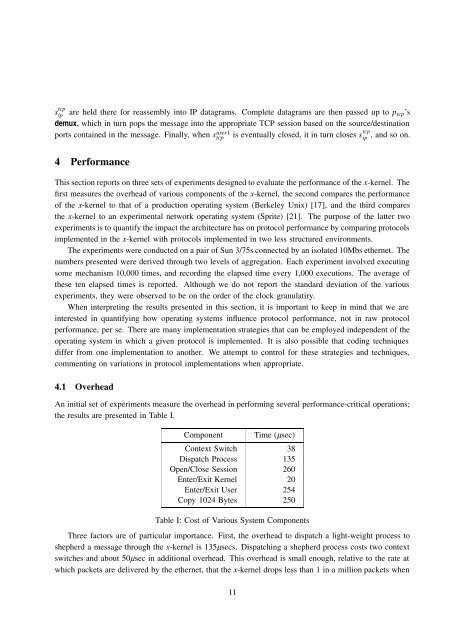The x-Kernel: An architecture for implementing network protocols - IDA
The x-Kernel: An architecture for implementing network protocols - IDA
The x-Kernel: An architecture for implementing network protocols - IDA
Create successful ePaper yourself
Turn your PDF publications into a flip-book with our unique Google optimized e-Paper software.
s tcp<br />
ip are held there <strong>for</strong> reassembly into IP datagrams. Complete datagrams are then passed up to p tcp ’s<br />
demux, which in turn pops the message into the appropriate TCP session based on the source/destination<br />
ports contained in the message. Finally, when s user1<br />
tcp<br />
4 Per<strong>for</strong>mance<br />
is eventually closed, it in turn closes s tcp<br />
ip<br />
, and so on.<br />
This section reports on three sets of experiments designed to evaluate the per<strong>for</strong>mance of the x-kernel. <strong>The</strong><br />
first measures the overhead of various components of the x-kernel, the second compares the per<strong>for</strong>mance<br />
of the x-kernel to that of a production operating system (Berkeley Unix) [17], and the third compares<br />
the x-kernel to an experimental <strong>network</strong> operating system (Sprite) [21]. <strong>The</strong> purpose of the latter two<br />
experiments is to quantify the impact the <strong>architecture</strong> has on protocol per<strong>for</strong>mance by comparing <strong>protocols</strong><br />
implemented in the x-kernel with <strong>protocols</strong> implemented in two less structured environments.<br />
<strong>The</strong> experiments were conducted on a pair of Sun 3/75s connected by an isolated 10Mbs ethernet. <strong>The</strong><br />
numbers presented were derived through two levels of aggregation. Each experiment involved executing<br />
some mechanism 10,000 times, and recording the elapsed time every 1,000 executions. <strong>The</strong> average of<br />
these ten elapsed times is reported. Although we do not report the standard deviation of the various<br />
experiments, they were observed to be on the order of the clock granulatiry.<br />
When interpreting the results presented in this section, it is important to keep in mind that we are<br />
interested in quantifying how operating systems influence protocol per<strong>for</strong>mance, not in raw protocol<br />
per<strong>for</strong>mance, per se. <strong>The</strong>re are many implementation strategies that can be employed independent of the<br />
operating system in which a given protocol is implemented. It is also possible that coding techniques<br />
differ from one implementation to another. We attempt to control <strong>for</strong> these strategies and techniques,<br />
commenting on variations in protocol implementations when appropriate.<br />
4.1 Overhead<br />
<strong>An</strong> initial set of experiments measure the overhead in per<strong>for</strong>ming several per<strong>for</strong>mance-critical operations;<br />
the results are presented in Table I.<br />
Component Time (µsec)<br />
Context Switch 38<br />
Dispatch Process 135<br />
Open/Close Session 260<br />
Enter/Exit <strong>Kernel</strong> 20<br />
Enter/Exit User 254<br />
Copy 1024 Bytes 250<br />
Table I: Cost of Various System Components<br />
Three factors are of particular importance. First, the overhead to dispatch a light-weight process to<br />
shepherd a message through the x-kernel is 135µsecs. Dispatching a shepherd process costs two context<br />
switches and about 50µsec in additional overhead. This overhead is small enough, relative to the rate at<br />
which packets are delivered by the ethernet, that the x-kernel drops less than 1 in a million packets when<br />
11

















